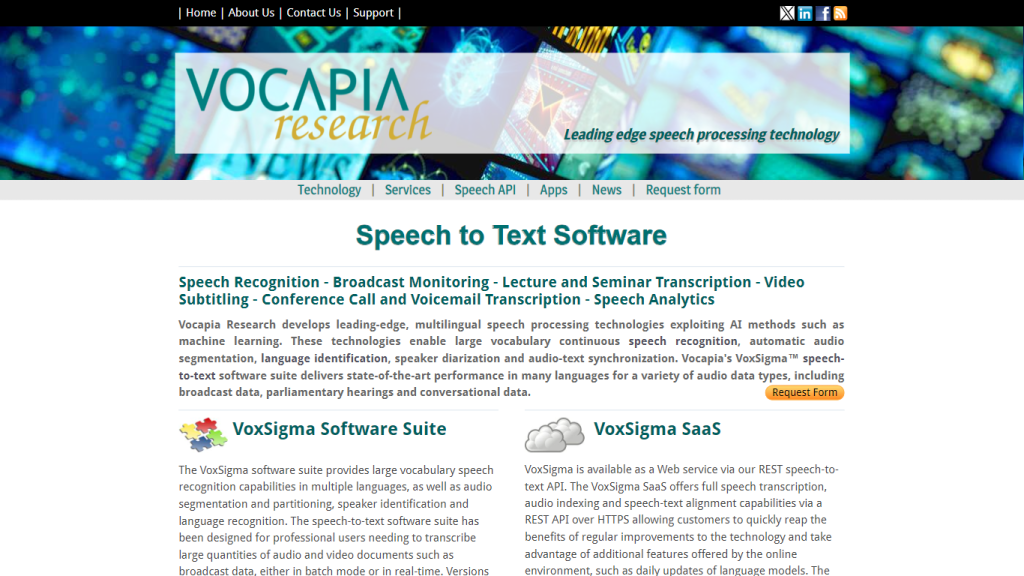What is Vocapia?
Vocapia is a high-end speech-to-text software suite developed to offer high-end language technology. It has a great variety of functionalities like speech recognition, language identification, speaker diarization, and speech-text alignment. Primarily, it is used to transcribe huge amounts of audio files, particularly video files, such as broadcast data and parliamentary hearings. This tool supports multiple languages and provides web services via a REST speech-to-text API, which is very helpful in telephone speech analytics and creating subtitles for videos.
Vocapia Key Features & Benefits
Vocapia has a long list of features and benefits that put it among the best options users in diverse fields can have. Some of its impressive features include the following:
- Speech recognition
- Language identification
- Speaker diarization
- Speech-text alignment
- Transcription of large amounts of audio and video
- Multilingual support
- Web services via REST speech-to-text API
- Telephone speech analytics
- Video subtitling
The benefits of using Vocapia include more efficient audio data processing due to strong multilingual support and model adaptation for client-specific projects. It is unique in being a fully packaged platform that suits varied transcription and speech processing applications.
Use Cases and Applications of Vocapia
Such versatility of Vocapia makes it applicable in many cases. Here are some examples of that:
- Transcribe large audio and video documents for archiving or analyzing them
- Treat telephonic conversations to uncover meaningful information from the discussions
- Subtitle video content accurately
The areas that it is most useful in are journalism, research, customer service, and content creation. For example, it could be used by transcriptionists to simplify their workload and also by video editors to generate subtitles at accuracy.
How to Use Vocapia
Using Vocapia is easy and convenient. The steps below will assist you in using Vocapia:
- Log in and create your account on the Vocapia website.
- Upload your audio or video file onto their webpage.
- After opening the uploaded file, select a language, and under settings, select Speaker Diarization or Audio Segmentation.
- Press Start Transcription and let this tool process the files.
- Once the processing is done, download the text transcribed by this software.
Make sure that your audio files are high quality and less than full of background noise. The user interface is user-friendly, with navigation menus that will help you go through clearly.
How Vocapia Works
Vocapia is based on advanced AI and machine learning algorithms for the delivery of accurate speech-to-text. These are aided by supporting technologies such as large vocabulary continuous speech recognition, automated audio segmentation, and speaker diarization. Interplaying with each other, these features allow transforming raw audio inputs into structured, searchable XML documents. Vocapia offers stand-alone Linux software as well as SaaS over a REST API, providing flexibility and reliability for all kinds of professional requirements.
Pros and Cons of Vocapia
Like any tool, Vocapia has its strengths and can potentially have their weaknesses.
Pros:
- State of the art speech recognition
- Language support is extended to a maximum number of languages
- Customizable models to your needs
- Both standalone software and SaaS
- 24/7 availability with geographic redundancy
Cons:
- High-quality audio may be needed for optimum results
- Freemium model possibly with fewer features than paid plans
User feedback has been overwhelmingly good with praise for the tool’s accuracy and reliability.
Conclusion about Vocapia
Finally, Vocapia remains a very strong and versatile speech-to-text solution, as advanced features, multilingual support, and customization capabilities make it a great tool for use within several professional domains. Looking ahead, continuous updates and developments would further enhance its functionality and user experience.
Vocapia FAQs
What are the provisions of Vocapia Research?
Vocapia Research provides leading-edge speech processing technologies, enabling large vocabulary continuous speech recognition and transcription services in multiple languages.
For whom is the VoxSigma software suite designed?
The VoxSigma software suite is intended for professionals looking to transcribe audio and video documents, among them broadcast data and call-center conversations.
What is VoxSigma SaaS, and what can be expected of it?
VoxSigma SaaS allows full speech transcription, audio indexing, and speech-text alignment through a REST API available 24/7 with failover and geographic redundancy.
In which languages is Vocapia’s speech-to-text software available?
It supports languages from Arabic to Urdu and has a language identification module that recognizes 82 languages.
Can Vocapia tune their speech recognition solutions to meet specific client requirements?
Yes, Vocapia offers services in adaptation and creation of custom models according to a client’s specific needs. This is to ensure high accuracy with optimal results.










